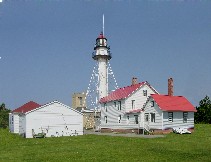
#wfmi001
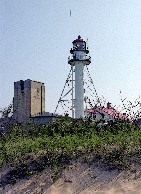
#wfmi002
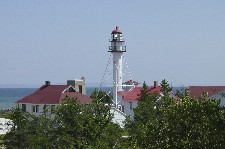
#wfmi003
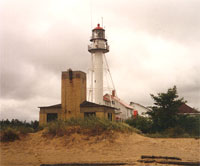
#wfmi004
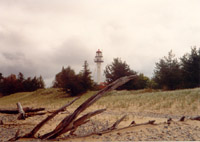
#wfmi005
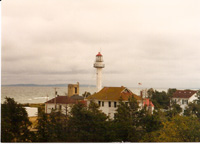
#wfmi006
 #wfmi001 |
 #wfmi002 |
 #wfmi003 |
||||||||||||||||||
 #wfmi004 |
 #wfmi005 |
 #wfmi006 |
The original light at this site dates from 1849, one of the two earliest lights on Lake Superior, with the other located at Copper Harbor, Michigan. The first tower 1849 lasted until 1861, when the present structure replaced it. The 76 ft. "iron pile" tower, with its skeletal braces appears modern yet, is over 140 years old. With the Civil War looming, and the first locks at the Soo operating since 1855, President Lincoln wanted to ensure the safe passage of the increasingly large number of vessels carrying iron ore, copper, and lumber from Michigan's Upper Peninsula. Originally outfitted with a fresnel lens, the light source is now an aerobeacon. Other buildings on the grounds include a Shipwreck Museum. The grounds are open to the public, and you can walk out onto the beach to the very "point" of Whitefish Point.
Whitefish Point marks the heavily traveled approach to Whitefish Bay and the Soo locks, on Michigan's Upper Peninsula. The lighthouse marks the end of an 80 mile stretch of shoreline known as Lake Superior's Shipwreck Coast, which is the site of more than half of the 550 known shipwrecks on the lake, including the infamous 729 ft. vessel Edmund Fitzgerald in November 1975. This light has shined onto the big lake unfailingly for almost 150 years except for, ironically, the night when the Edmund Fitzgerald went down. It is the only active light remaining along the southeast shore of Lake Superior. It stands guard over the entrance to Whitefish Bay, sometimes the only shelter to be found for a ship trying to escape the fury of the lake.
Lake Superiorís ferocity is characterized by raging northwest winds, that build up over the 160 miles of open water, creating waves of unbelievable proportions. These violent storms and wild waters erupt with a suddenness that often catch mariners off guard. The mountainous waves strike harder and more often that any ocean wave. The waves come roaring in from two or three different directions, bouncing off the shores and returning with even more intensity. Huge storms, of hurricane force and duration, can strike with all the ferocity and brutality of any ocean born tropical cyclone.